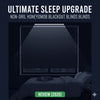Perfect Fit Blinds vs. Traditional Fitted Blinds: Which Is Right for Your Home?
- by Mariam Labadze
Quick Answer
Perfect Fit blinds attach directly to uPVC window frames using clever brackets that require no drilling, whilst traditional fitted blinds mount to walls or window recesses with screws. Perfect Fit systems sit flush against the glass, ideal for tilt-and-turn windows and doors, maintaining full opening functionality. Traditional blinds offer more style variety and work with any window type but require drilling and can obstruct window operation. Your choice depends on window type, rental status, desired aesthetic, and whether preserving frame integrity matters. Both options provide excellent light control and privacy when properly selected for your specific needs.
[toc]
Key Differences at a Glance
-
Installation method – Perfect Fit uses clip-on brackets without drilling; traditional blinds require screws into walls or frames
-
Window compatibility – Perfect Fit excels with uPVC, tilt-and-turn windows; traditional suits all window types including sash and timber
-
Aesthetic appearance – Perfect Fit creates streamlined, contemporary look; traditional offers more diverse styling options
-
Reversibility – Perfect Fit leaves no damage, ideal for rentals; traditional installations leave permanent holes
-
Cost considerations – Perfect Fit typically costs more initially but requires no professional installation in many cases
-
Style variety – Traditional blinds available in wider range of materials and designs
-
Functionality with doors – Perfect Fit allows doors to open freely without blind interference
Understanding Perfect Fit Blind Systems
Perfect Fit blinds revolutionized window treatments when they entered the UK market, addressing common frustrations with traditional installations. The system uses a slim frame that clips onto uPVC window beads, holding the blind flush against the glass without penetrating the frame.
This design means the blind moves with the window when it opens, rather than remaining stationary on the wall. For tilt-and-turn windows commonly found in modern UK homes, this functionality proves invaluable. You can open windows fully for cleaning or ventilation without removing or working around blinds.
The frames come in white, brown, or grey to match standard uPVC colors, creating a cohesive, built-in appearance. Because they sit directly against the glass, Perfect Fit blinds minimize light gaps at the sides, providing superior light blocking compared to some recess-mounted traditional alternatives.
The system works with various blind types including pleated, venetian, and roller styles, offering reasonable variety within the Perfect Fit framework. However, the selection remains narrower than traditional options, focusing on practical designs rather than extensive decorative choices.
How Traditional Fitted Blinds Work
Traditional blinds represent the established approach to window coverings, offering two primary mounting methods. Recess mounting places brackets inside the window frame, allowing the blind to sit within the architectural opening. This creates a neat, integrated look that maximizes wall space around windows.
Face-fix mounting attaches brackets to the wall or ceiling above the window, with the blind covering both the glass and surrounding frame. This method suits shallow recesses, provides better light blocking, and can make windows appear larger by extending coverage beyond actual window dimensions.
Both approaches require drilling holes for screws, creating permanent alterations to your property. This isn't problematic for homeowners but presents challenges for renters who need landlord permission and must repair holes when moving.
Traditional blinds offer extraordinary variety in materials, colors, patterns, and operating mechanisms. From luxurious wooden venetians to sleek motorized rollers, from blackout fabrics to delicate voiles, the options span every aesthetic and functional requirement imaginable.
Installation Comparison
Perfect Fit installation often qualifies as a DIY project for confident homeowners. The process involves measuring window beads accurately, ordering custom-sized frames, and clipping them onto the window. No tools beyond a tape measure are typically required, though some installations benefit from a screwdriver to adjust tension.
The clip-on mechanism means mistakes aren't costly. If frames don't fit perfectly, they simply won't clip on securely, prompting remeasurement rather than leaving permanent damage. This forgiving nature makes Perfect Fit appealing for first-time installers.
Traditional blind installation requires drilling precise holes, securely fastening brackets, and hanging blinds level. Mistakes can damage walls or frames, requiring repair. Many homeowners prefer professional installation to ensure proper positioning, particularly for expensive blinds or challenging window configurations.
Professional installation for traditional blinds typically costs £30-£60 per window, adding to overall project expenses. However, expert installation guarantees optimal fit, function, and appearance, potentially justifying the investment.
When Perfect Fit Blinds Excel
Modern uPVC windows represent Perfect Fit's ideal environment. The system was specifically designed for these frames, ensuring reliable compatibility and seamless integration. If your home features contemporary double-glazing throughout, Perfect Fit offers tremendous advantages.
Rental properties benefit enormously from reversible installations. Tenants can personalize spaces without risking deposits or requiring landlord approvals for drilling. When moving, simply unclip the blinds and take them or leave frames damage-free.
Tilt-and-turn windows function properly only with Perfect Fit or similar systems. Traditional blinds mounted on walls prevent windows from opening inward, negating a key feature of this window style. Perfect Fit preserves full functionality.
French doors and patio doors with glass panels pose challenges for traditional blinds. Perfect Fit systems attach to each door panel independently, moving with the door when opened and maintaining unobstructed access without catching or tangling.
Minimalist aesthetics suit Perfect Fit's clean, integrated appearance. The system virtually disappears into the window architecture, supporting contemporary design philosophies that favor simplicity and uncluttered spaces.
When Traditional Blinds Are Better
Older properties with timber windows often can't accommodate Perfect Fit systems designed for uPVC beading. Traditional mounting works universally regardless of window material, age, or style, making it essential for period properties.
Sash windows require traditional approaches since Perfect Fit frames can't attach to sliding mechanisms. Recess-mounted traditional blinds work beautifully with sash windows, preserving historical character whilst providing modern light control.
Design variety requirements favor traditional options. If you envision specific fabrics, patterns, textures, or luxury materials, traditional blinds offer incomparably broader selection. Perfect Fit's limited range may feel restrictive for particular aesthetic visions.
Shallow or non-existent window recesses benefit from face-fix traditional mounting. This flexibility allows blinds in any architectural configuration, whereas Perfect Fit requires sufficient frame depth for clip-on installation.
Budget consciousness sometimes favors traditional options. Basic roller or venetian blinds can cost less than Perfect Fit systems, particularly when DIY installation is feasible. For multiple windows, cost differences accumulate significantly.
Cost Analysis
Perfect Fit systems typically cost 20-40% more than equivalent traditional blinds due to the custom frames and specialized hardware. A Perfect Fit roller blind might cost £80-£120 per window, whilst a traditional roller could be £50-£80.
However, Perfect Fit often eliminates professional installation costs. If you'd pay £40 per window for traditional blind installation, the savings narrow considerably. For five windows, you'd spend £200 on installation alone, potentially making Perfect Fit more economical overall.
Consider long-term value when comparing costs. Perfect Fit's portability means you can take blinds when moving, unlike traditional installations left behind. This reusability factor makes Perfect Fit potentially more economical for tenants who move frequently.
Traditional blinds might require replacement if you redecorate and want different styles. Perfect Fit frames can accept new blind inserts without replacing the entire system, offering some adaptability without complete replacement.
Making Your Decision
Assess your specific circumstances honestly. Homeowners with period properties, timber windows, or strong design preferences typically find traditional blinds more suitable. Renters, modern home owners with uPVC windows, and those valuing quick, damage-free installation gravitate toward Perfect Fit.
Consider your window types throughout your home. Mixed window styles might necessitate combining approaches—Perfect Fit for modern uPVC windows and doors, traditional for older timber windows or special architectural features.
Think about timeframe and installation confidence. Need window treatments quickly without arranging professional installers? Perfect Fit offers immediate solutions. Prefer expert installation ensuring perfect results? Traditional blinds provide that option.
Budget constraints matter but shouldn't be the sole deciding factor. Cheaper options that don't meet your needs deliver poor value regardless of initial savings. Invest in the approach that genuinely solves your requirements.
Both Perfect Fit and traditional systems available through 1 Click Blinds deliver excellent performance when properly matched to your situation. Understanding your priorities—whether reversibility, design variety, window compatibility, or installation simplicity—guides you toward the right choice for your home.







